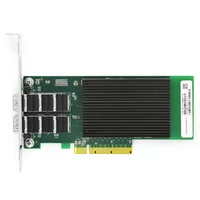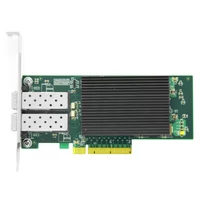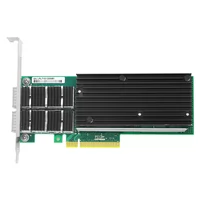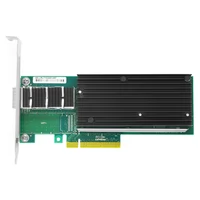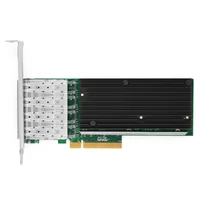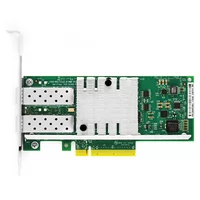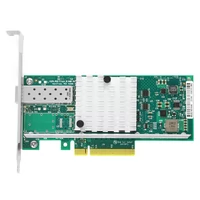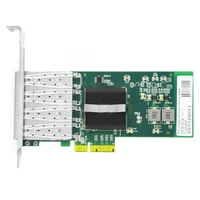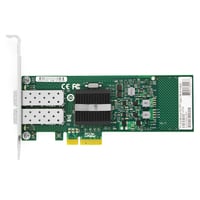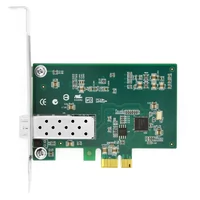The server network card provided by FiberMall is mainly used for fiber optic Ethernet. The Ethernet communication protocol is used for signal transmission and is usually connected to the fiber-optic Ethernet switch through a fiber-optic cable.
The transmission rate can be divided into 1000Mbps、1Gbps、10Gbps ,25G bps,40Gbps. According to the type of motherboard socket, it can be divided into PCI, PCI-X, PCI-E (x1/x4/x8/x16), etc.
According to the interface type, it is divided into LC, SC, FC, ST, and so on.
According to the type of motherboard socket, it can be divided into PCI, PCI-X, PCI-E (x1/x4/x8/x16), etc.
According to the interface type, it is divided into LC, SC, FC, ST, and so on.
Table of Contents
ToggleEthernet Card

General Characteristics

-
- RS-F8028 plug and play
-
- Compatible with IEEE 802.3z 1000Base-SX / 1000Base-LX Ethernet standards
-
- 100Mbps or 1000Mbps Ethernet fiber access
-
- PCI-X standard compatible
-
- Support IEEE 802.3x flow control to support IP unicast, broadcast, a multicast address filtering mechanism
-
- Support priority queue support IEEE 802.1Q/VLAN tag support IP multicast packet filtering, reducing CPU occupancy
-
- Advanced management capabilities
-
- Network protocols and standards:
-
- IEEE 802.3Z 1000Base-SX / 1000Base-LX Ethernet standard
-
- IEEE 802.3x Flow Control Protocol
-
- IEEE 802.1q VLAN tagging
-
- GVRP VLAN Registration Agreement
-
- IEEE 802.1p priority control
-
- ACPI 2.0 Advanced Configuration and Power Management Interface
-
- PCI-X standard
-
- Optical fiber port working wavelength and transmission distance:
-
- Single-mode single fiber, 1310nm/1550nm, 20/40/60km
-
- Single-mode dual fiber, 850nm, 1310nm or 1550nm, 0.5/10/20/40/60/km driver:
-
- Microsoft Windows 95/ 98/ 98 SE/2000/ XP Microsoft NT 3.51 / 4.0
-
- Microsoft Windows for Workgroups 3.11
-
- Microsoft Windows CE NET 4.0 / 4.2 Microsoft Client for DOS
-
- NDIS 2/3/4/5 driver
-
- ODI for DOS driver
-
- 32 bit ODI LAN driver
-
- working environment:
-
- Storage temperature: -25°C~ 85°C (-13~ 131°F)
-
- Working temperature: 0°C~ 50°C (32~ 122°F)
-
- Relative humidity: 10% ~ 90% without condensation
-
- Power consumption: 2W
Identification
Identify the true and false of the network card, here are some conditions that a good NIC should have:
(1) using a tin plate. The circuit board of the high-quality network card generally adopts the tin-spraying board, the network cardboard is white, and the inferior network card is yellow.
(2) using a high-quality main control chip. The main control chip is the most important component of the network card. It often determines the performance of the network card. Therefore, the main control chip used by the high-quality network card should be a mature product on the market. Many inferior NICs on the market use older versions of the main control chip in order to reduce costs, which undoubtedly gives a discount to the performance of the NIC.
(3) Most use SMT chip components In addition to electrolytic capacitors and high-voltage ceramic capacitors, high-quality network cards use SMT chip components that are more reliable and stable than plug-ins. Inferior NICs mostly use plug-ins, which makes the NIC’s heat dissipation and stability not good enough.
Factors to consider when purchasing a network card Whether the network card can be properly selected, connected, and set during assembly is often the prerequisite and necessary condition for proper network connection. In general, the following factors should be considered when purchasing a network card: Network Type The more popular ones are Ethernet, Token Ring, FDDI, etc. When selecting, the corresponding network card should be selected according to the type of network.
High-Security Performance
The server not only needs to have strong service performance but also has absolutely assured security measures. In practical applications, whether the network cable is broken, the hub or switch port is broken, or the network card is broken, the connection will be interrupted. Of course, the consequences are unimaginable. There are many factors that affect the normal operation of the server. Among them, the network card directly connected with the outside world is one of the most important links. To this end, many network hardware vendors have introduced their own fault-tolerant server network cards. For example, Intel introduced three fault-tolerant servers NICs, which use Adapter Fault Tolerance (AFT, NIC error redundancy), Adapter Load Balancing (ALB, NIC load balancing), Fast Ether Channel (FEC, Fast Ethernet Channel) technology. AFT technology is to establish a redundant connection between the server and the switch, that is, install two network cards on the server, one as the primary network card, and the other as the backup network card, and then connect the two network cards to the switch with two network cables. Establish a primary and backup connection between the server and the switch. Once the primary connection fails due to a broken data line or a network transmission failure, the alternate connection automatically replaces the primary connection within a few seconds, and the network user is usually unaware of any changes. In this way, the entire network is prevented from being damaged due to the failure of one line, which can greatly improve the security and reliability of the network. ALB is a simple and easy way to get the server to transfer data more quickly. The new technology increases throughput by balancing data traffic across multiple NICs, adding 1000 Mbps for each additional NIC. In addition, ALB also has the same fault tolerance function of AFT. Once one link fails, other links can still guarantee the network connection. When the server network card becomes the network bottleneck, the ALB technology does not need to divide the network segment. The network administrator only needs to install two ALB-capable network cards on the server and configure the door to the ALB state to solve the bottleneck problem quickly and easily. . FEC is a bandwidth-enhancing technology developed by Cisco for applications such as Web browsing and Intranet that require high throughput. FEC also provides high reliability and speed for customer/server networks for critical applications. AFT, ALB, and FEC use the same driver. A network card group can only use one set at the same time. The technology used in the system depends on the specific situation.
Transmission Rate
The NIC’s transfer rate should be chosen based on the bandwidth requirements of the server or workstation combined with the maximum transfer rate that the physical transport medium can provide. Taking Ethernet as an example, the selectable rate is 10 Mbps, 10 / 100 Mbps, 1000 Mbps, or even 10 Gbps, 25 Gbps, 40 Gbps, etc., but the higher the rate, the more appropriate. For example, configuring a 1000M network card for a computer connected to a twisted pair cable with only 100M transmission speed is a waste because it can only achieve a transmission rate of 100M at most.
Bus Type
Servers and workstations usually use PCI, PCI-X, or PCI-E bus smart network card, PC basically no longer supports ISA connection, so when buying a network card for your PC, do not buy outdated The ISA network card should be purchased with PCI, PCI-X, and PCI-E network cards.
Server Network Card Supported Interface
The network card is ultimately connected to the network, so there must be an interface through which the network cable is connected to other computer network devices. Different network interfaces are available for different network types. Common interfaces include Ethernet RJ-45 interfaces and LC, SC, and FC fiber interfaces.
Price and brand
Different rates, different brands of network card prices vary widely.
Characteristic
-
- Plug and play Compatible with IEEE 802.3z 1000Base-SX / 1000Base-LX Ethernet standards for 100Mbps or 1000Mbps Ethernet fiber access, working in full/half-duplex mode, available in full-duplex mode 200Mbps or 2000Mbps bandwidth PCI-X standard compatible
-
- Support IEEE 802.3x flow control
-
- Support IP unicast, broadcast, multicast address filtering mechanism Support for priority queues
-
- Support for IEEE 802.1Q/VLAN tagging
-
- Support IP multicast packet filtering, reducing CPU occupancy
-
- Advanced management capabilities
-
- Fiber Ethernet Card Network Protocol and Standard IEEE 802.3Z 1000Base-SX / 1000Base-LX Ethernet Standard
-
- IEEE 802.3x Flow Control Protocol
-
- IEEE 802.1q VLAN tagging GVRP VLAN Registration Agreement
-
- IEEE 802.1p priority control ACPI 2.0
-
- Advanced Configuration and Power Management Interface
-
- PCI-X standard
Classification

(1) PCI-X bus network card
This is the latest type of network card that is used at the beginning of the server.
Compared with the original PCI, it has doubled the I/O speed and has a faster data transfer speed than the PCI interface (2.0 version can achieve a transfer rate of up to 266MB/s). This type of bus type network card is still rare in the market, mainly provided by the server manufacturer randomly, as seen in IBM’s X series server. The network card of the PCI-X bus interface is generally 32-bit bus width, and some are 64-bit data width. However, due to the exclusion of Intel’s new bus standard PCI-Express, it is still unknown whether it will eventually become popular, because Intel proposed PCI-SIG (PCI Special Interest Organization) PCI-Express, both in terms of speed and structure. Both are much stronger than the PCI-X bus. Intel’s i875P chipset has provided support for the PCI-Express bus, and expert analysis will gradually popularize this new bus interface. It will replace the PCI and the current AGP interface, and ultimately achieve the unification of the internal bus interface.
(2) PCI-E bus network card
The PCI Express interface varies depending on the bus width, including X1, X4, X8, and X16 (X2 mode will be used for the internal interface instead of the slot mode). Shorter PCI Express cards can be inserted into longer PCI Express slots for use. The PCI Express interface is capable of supporting hot plugging, which is also a big leap. The three voltages supported by the PCI Express card are +3.3V, 3.3Vaux, and +12V. The PCI Express interface used to replace the AGP interface has a bit width of X16 and will be able to provide 5GB/s of bandwidth. Even with the loss of coding, it can still provide about 4GB/s of actual bandwidth, far exceeding the AGP 8X’s 2.1GB/ s bandwidth.

Chip
The chip is one of the most important components on the network card, directly determines the quality of the network card. At present, the mainstream chips include intel, Realtek, Broadcom, and VIA. The entire FiberMall series uses Intel chips because of the compatibility of Intel chips. Stability and reliability are among the best of all brands.

Related Products:
-
 Intel® X710-BM2 DA2 Dual Port 10 Gigabit SFP+ PCI Express x8 Ethernet Network Interface Card PCIe v3.0
$179.00
Intel® X710-BM2 DA2 Dual Port 10 Gigabit SFP+ PCI Express x8 Ethernet Network Interface Card PCIe v3.0
$179.00
-
 Intel® XXV710 DA2 Dual Port 25 Gigabit SFP28 PCI Express x8 Ethernet Network Interface Card PCIe v3.0
$269.00
Intel® XXV710 DA2 Dual Port 25 Gigabit SFP28 PCI Express x8 Ethernet Network Interface Card PCIe v3.0
$269.00
-
 Intel® XL710 QDA2 Dual Port 40 Gigabit QSFP+ PCI Express x8 Ethernet Network Interface Card PCIe v3.0
$359.00
Intel® XL710 QDA2 Dual Port 40 Gigabit QSFP+ PCI Express x8 Ethernet Network Interface Card PCIe v3.0
$359.00
-
 Intel® XL710-BM1 QDA1 Single Port 40 Gigabit QSFP+ PCI Express x8 Ethernet Network Interface Card PCIe v3.0
$309.00
Intel® XL710-BM1 QDA1 Single Port 40 Gigabit QSFP+ PCI Express x8 Ethernet Network Interface Card PCIe v3.0
$309.00
-
 Intel® XL710-BM1 DA4 Quad Port 10 Gigabit SFP+ PCI Express x8 Ethernet Network Interface Card PCIe v3.0
$309.00
Intel® XL710-BM1 DA4 Quad Port 10 Gigabit SFP+ PCI Express x8 Ethernet Network Interface Card PCIe v3.0
$309.00
-
 Intel® 82599ES SR2 Dual Port 10 Gigabit SFP+ PCI Express x8 Ethernet Network Interface Card PCIe v2.0
$159.00
Intel® 82599ES SR2 Dual Port 10 Gigabit SFP+ PCI Express x8 Ethernet Network Interface Card PCIe v2.0
$159.00
-
 Intel® 82599EN SR1 Single Port 10 Gigabit SFP+ PCI Express x8 Ethernet Network Interface Card PCIe v2.0
$115.00
Intel® 82599EN SR1 Single Port 10 Gigabit SFP+ PCI Express x8 Ethernet Network Interface Card PCIe v2.0
$115.00
-
 Intel® I350 F4 Quad Port Gigabit SFP PCI Express x4 Ethernet Network Interface Card PCIe v2.1
$180.00
Intel® I350 F4 Quad Port Gigabit SFP PCI Express x4 Ethernet Network Interface Card PCIe v2.1
$180.00
-
 Intel® 82576 F2 Dual Port Gigabit SFP PCI Express x4 Ethernet Network Interface Card PCIe v2.0
$68.00
Intel® 82576 F2 Dual Port Gigabit SFP PCI Express x4 Ethernet Network Interface Card PCIe v2.0
$68.00
-
 Intel® I210 F1 Single Port Gigabit SFP PCI Express x1 Ethernet Network Interface Card PCIe v2.1
$60.00
Intel® I210 F1 Single Port Gigabit SFP PCI Express x1 Ethernet Network Interface Card PCIe v2.1
$60.00

